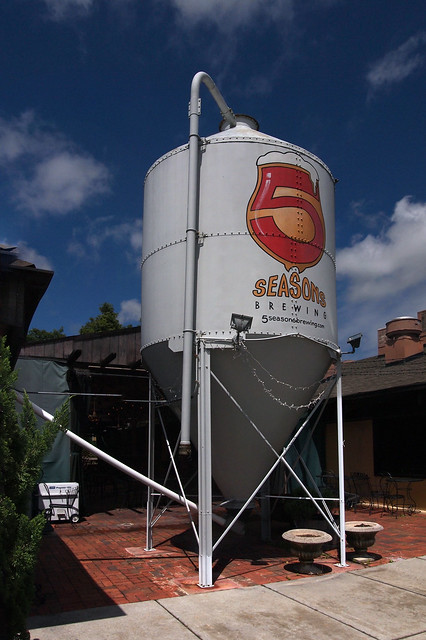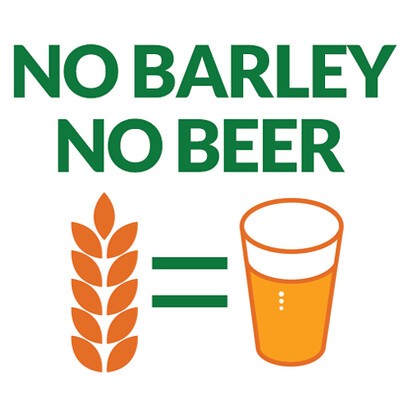Many 'craft' beer drinkers tend to pay hops a lot of attention, yet barley malt not so much. Incorrectly. Hops are herbs, spice in beer. It is malt that is beer's fermentable foundation —its quiet soul.
Woe to the malster, brewer, or distiller who simply treats malt as a commodity ingredient. Understanding the relationships between hydration, food reserves, and enzymes within the cereal grain can make the difference between a good tasting product and a great tasting product. The role of maltsters, brewers, and distillers [is] one of "fashioning into a scientifically controlled industry, the noble art of converting barley malt into a wort upon which yeast may feast and ultimately fatten into a beverage with character."— The Craft Maltster's' Handbook.
Dave Thomas. White Mule Press (August 2014).
Pictured above is a grain silo holding barley malt for a later brew at the 5 Seasons Brewpub, as seen on 22 April 2016, under a deep blue sky in Sandy Springs, Georgia.
But what is barley and what is barley malt? The National Barley Growers Association has a pithy answer:
The The Oxford Companion to Beer (Oxford University Press, 2012) provides more depth:
Barley is the primary cereal grain used as the source of carbohydrates for brewing beer. It is designated Hordeum vulgare, and originates in the fertile Crescent of the Middle East (formerly Mesopotamia and its surroundings, now Syria, Iraq and surrounding lands). [...]
Malting is the process in which raw barley or another grain is made ready to become the main ingredient in the brewing process. It is essentially the first step in beer making. The grain is steeped in water, then rested under precise conditions to encourage germination, and finally dried in a kiln and/or a roaster. One of the key functions of malting is to degrade the grain's proteins and to create the enzymes and modify the starches needed for the brewing process. Professionally, the person responsible for this process is known as a maltster.
Returning to the silo above and referring to its brewpub, a question might arise: What is the fifth season?
The answer is ... beer-drinking season, of course. You can thank a barleycorn for that. And a farmer. And a maltster.
-----more-----
- More photos of 5 Seasons Brewpub: here.
- Barley malt resources:
- National Barley Growers Association [U.S.].
- [North American] Craft Malsters Guild.
- The Craft Maltsters' Handbook. Dave Thomas. White Mule Press (2014).
- Malt: A Practical Guide from Field to Brewhouse. John Mallet. Brewers Publications (2014).
- Technology Brewing & Malting. Wolfgang Kunze. VLB Berlin (2014).
- Toward the development of barley varieties specifically for the needs of 'craft' brewers.
- Amber Waves of Grain. Adrienne So. Beer West Magazine (2010).
- Malt Varieties for Craft Brewers. Dr. Juliet Marshall, University of Idaho. (YFGF: 2013).
- Pic(k) of the Week: one in a weekly series of personal photos, usually posted on Saturdays, and often, but not always, with a good fermentable as the subject. Camera: Olympus Pen E-PL1.
- Commercial reproduction requires explicit permission, as per Creative Commons.
- For more from YFGF:
- Follow on Twitter: @Cizauskas.
- Like on Facebook: YoursForGoodFermentables.
- Follow on Flickr: Cizauskas.
- Follow on Instagram: @tcizauskas.











No comments:
Post a Comment
Comment here ...